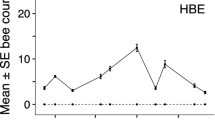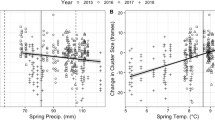Abstract
Competition between managed honeybees and wild pollinators is thought to be a key factor in structuring foraging communities on flowers. The majority of studies have focused on impacts such as floral visitation rates and resource overlap. However, direct measurement of fitness is required to fully assess the impacts of competition. We compared in 2 years the weight and reproductive success of bumblebee colonies located at two sites that were either close to or far from a large honeybee apiary, and which were located in the same landscape and with access to similar floral resources. We found that bumblebee colonies located at the site near the honeybee apiary gained less weight, and produced fewer and smaller queens, in both years than colonies at the site far from the apiary. The ratio of queen weight/size was lower in the colonies near honeybees in 1 year, while males were smaller and offspring sex ratio more male biased in colonies close to honeybees than in those far from honeybees. Proximity to managed honeybee hives was therefore associated with significantly reduced fitness of bumblebee colonies, but studies from many more sites are needed to confirm the effect.


Similar content being viewed by others
References
Beekman, M., Van Stratum, P. (1998) Bumblebee sex ratios: why do bumblebees produce so many males? Proc. R. Soc. Lond. B 265, 1535–1543
Beekman, M., Van Stratum, P., Lingeman, R. (1998) Diapause survival and post-diapause performance in bumblebee queens (Bombus terrestris). Entomol. Exp. Appl. 89, 207–214
Blanckenhorn, W.U. (2000) The evolution of body size: what keeps organisms small? Q. Rev. Biol. 75, 385–407
Butz Huryn, V.M. (1997) Ecological impacts of introduced honey bees. Q. Rev. Biol. 72, 275–297
Cameron, S.A., Lozier, J.D., Strange, J.P., Koch, J.B., Cordes, N., Solter, L.F., Griswold, T.L. (2011) Patterns of widespread decline in North American bumblebees. Proc. Natl. Acad. Sci. USA 108, 662–667
Colla, S.R., Packer, L. (2008) Evidence for decline in eastern North American bumblebees (Hymenoptera: Apidae), with special focus on Bombus affinis Cresson. Biodivers. Conserv. 17, 1379–1391
Corbet, S.A., Saville, N.M., Fussell, M., Prys-Jones, O.E., Unwin, D.M. (1995) The competition box: a graphical aid to forecasting pollinator performance. J. Appl. Ecol. 32, 707–719
Couvillon, M.J., Dornhaus, A. (2009) Location, location, location: larvae position inside the nest is correlated with adult body size in worker bumble-bees (Bombus impatiens). Proc. Biol. Sci. B 276, 2411–2418
Denno, R.F., Mcclure, M.S., Ott, J.R. (1995) Interspecific interactions in phytophagous insects: competition reexamined and resurrected. Annu. Rev. Entomol. 40, 297–331
Durrer, S., Schmid-Hempel, P. (1994) Shared use of flowers leads to horizontal pathogen transmission. Proc. R. Soc. Lond. B 258, 299–302
Fontaine, C., Dajoz, I., Meriguet, J., Loreau, M. (2006) Functional diversity of plant–pollinator interaction webs enhances the persistence of plant communities. PLoS Biol. 4, 129–135
Garibaldi, L.A., Steffan-Dewenter, I., Kremen, C., Morales, J.M., Bommarco, R., et al. (2011) Stability of pollination services decreases with isolation from natural areas despite honey bee visits. Ecol. Lett. 14, 1062–1072
Garibaldi, L.A., Steffan-Dewenter, I., Winfree, R., Aizen, M.A., Bommarco, R., et al. (2013) Wild pollinators enhance fruit set of crops regardless of honey bee abundance. Science 339, 1608–1611
Genersch, E., Yue, C., Fries, I., De Miranda, J.R. (2006) Detection of deformed wing virus, a honey bee viral pathogen, in bumble bees (Bombus terrestris and Bombus pascuorum) with wing deformities. J. Invertebr. Pathol. 91, 61–63
Ginsberg, H.S. (1983) Foraging ecology of bees in an old field. Ecology 64, 165–175
Goulson, D. (2004) Keeping bees in their place: impacts of bees outside their native range. Bee World 85, 45–46
Goulson, D., Sparrow, K. (2009) Evidence for competition between honeybees and bumblebees; effects on bumblebee worker size. J. Insect Conserv. 13, 177–181
Goulson, D., Hughes, W.O.H., Derwent, L.C., Stout, J.C. (2002a) Colony growth of the bumblebee, Bombus terrestris, in improved and conventional agricultural and suburban habitats. Oecologia 130, 267–273
Goulson, D., Peat, J., Stout, J.C., Tucker, J., Darvill, B., Derwent, L.C., Hughes, W.O.H. (2002b) Can alloethism in workers of the bumblebee, Bombus terrestris, be explained in terms of foraging efficiency? Anim. Behav. 64, 123–130
Graystock, P., Yates, K., Evison, S.E.F., Darvill, B., Goulson, D., Hughes, W.O.H. (2013a) The Trojan hives: pollinator pathogens, imported and distributed in bumblebee colonies. J. Appl. Ecol. 50, 1207–1215
Graystock, P., Yates, K., Darvill, B., Goulson, D., Hughes, W.O.H. (2013b) Emerging dangers: deadly effects of an emergent parasite in a new pollinator host. J. Invert. Pathol. 114, 114–119
Gross, C.L. (1993) The breeding system and pollinators of Melastoma affine (Melastomataceae); a pioneer shrub in tropical Australia. Biotropica 25, 468–474
Holland, J., Guidat, F.S., Bourke, A.F.G. (2013) Queen control of a key life-history event in a eusocial insect. Biol. Lett. 9, 20130056
Holm, S.N. (1972) Weight and life length of hibernating bumble bee queens (Hymenoptera: Bombidae) under controlled conditions. Insect Syst. Evol. 3, 313–320
Inoue, M.N. (2011) Size-dependent selection against small queens of the invasive bumblebee Bombus terrestris in Japan. Entomol. Exp. Appl. 138, 65–70
Kosior, A., Celary, W., Olejniczak, P., Fijal, J., Król, W., Solarz, W., Plonka, P. (2007) The decline of the bumble bees and cuckoo bees (Hymenoptera: Apidae: Bombini) of Western and Central Europe. Oryx 41, 79–88
Oldroyd, B.P., Lawler, S.H., Crozier, R.H. (1994) Do feral honey bees (Apis mellifera) and regent parrots (Polytelis anthopeplus) compete for nest sites? Aust. J. Ecol. 19, 444–450
Owen, R.E. (1988) Body size variation and optimal body size of bumble bee queens (Hymenoptera: Apidae). Can. Entomol. 120, 19–27
Paini, D.R. (2004) Impact of the introduced honey bee (Apis mellifera) (Hymenoptera: Apidae) on native bees: a review. Austral Ecol. 29, 399–407
Peat, J., Darvill, B., Ellis, J., Goulson, D. (2005a) Effects of climate on intra- and interspecific size variation in bumble-bees. Funct. Ecol. 19, 145–151
Peat, J., Tucker, J., Goulson, D. (2005b) Does intraspecific size variation in bumblebees allow colonies to efficiently exploit different flowers? Ecol. Entomol. 30, 176–181
Roubik, D.W. (1983) Experimental community studies: time-series tests of competition between African and neotropical bees. Ecology 64, 971–978
Roubik, D.W., Wolda, H. (2001) Do competing honey bees matter? Dynamics and abundance of native bees before and after honey bee invasion. Popul. Ecol. 43, 53–62
Schaffer, W.M., Zeh, D.W., Buchmann, S.L., Kleinhans, S., Schaffer, M.V., Antrim, J. (1983) Competition for nectar between introduced honey bees and native North American bees and ants. Ecology 64, 564–577
Spaethe, J., Weidenmüller, A. (2002) Size variation and foraging rate in bumblebees (Bombus terrestris). Insectes Soc. 49, 142–146
Sugden, E.A., Pyke, G.H. (1991) Effects of honey bees on colonies of Exoneura asimillima, an Australian native bee. Aust. J. Ecol. 16, 171–181
Sugden, E.A., Thorp, R.W., Buchmann, S.L. (1996) Honey bee-native bee competition: focal point for environmental change and apicultural response in Australia. Bee World 77, 26–44
Szabo, N.D., Colla, S.R., Wagner, D.L., Gall, L.F., Keer, J.T. (2012) Do pathogen spillover, pesticide use, or habitat loss explain recent North American bumblebee declines? Cons. Lett. 5, 232–239
Thomson, D. (2004) Competitive interactions between the invasive European honey bee and native bumble bees. Ecology 85, 458–470
Thomson, D.M. (2006) Detecting the effects of introduced species: a case study of competition between Apis and Bombus. Oikos 114, 407–418
Thornhill, R., Alcock, J. (2000) The evolution of insect mating systems. Harvard Univ. Press, Cambridge
Walther-Hellwig, K., Fokul, G., Frankl, R., Büchler, R., Ekschmitt, K., Wolters, V. (2006) Increased density of honeybee colonies affects foraging bumblebees. Apidologie 37, 517–532
Wenner, A.M. (1992) Removal of feral honey bee (Apis mellifera) colonies from Santa Cruz Island. In: Halverson, W.L., Maender, G.J. (eds.) Fourth California Islands Symposium: Update on the Status of Resources, pp. 351–365. Santa Barbara Mus. Nat. Hist, Santa Barbara
Westphal, C., Steffan-Dewenter, I., Tscharntke, T. (2006) Foraging trip duration of bumblebees in relation to landscape-wide resource availability. Ecol. Entomol. 31, 389–394
Williams, P.H., Osborne, J.L. (2009) Bumblebee vulnerability and conservation world-wide. Apidologie 40, 367–387
Wilms, W., Wiechers, B. (1997) Floral resource partitioning between native Melipona bees and the introduced Africanized honey bee in the Brazilian Atlantic rain forest. Apidologie 28, 339–355
Acknowledgments
We are grateful to Holly Mottershead, Chris Wright and Martin Lappage for assistance with field work, and the two anonymous reviewers for their constructive comments. This research was funded by the Higher Education Ministry of Libya.
Author information
Authors and Affiliations
Corresponding author
Additional information
Manuscript editor: James Nieh
Effet de la présence proche d’un rucher d’abeilles sur une colonie de bourdons en terme de santé, développement et performance
Écologie / pollinisateur / compétition interspécifique / Bombus terrestris / Apis mellifera
Der Effekt der Nähe zu einem Bienenstand auf die Fitness, die Entwicklung und die Leistungsfähigkeit von Hummelkolonien
Bestäuberökologie / Wettbewerb / Bienen / Bombus terrestris / Apis mellifera
Electronic supplementary material
Below is the link to the electronic supplementary material.
ESM 1
(PDF 155 kb)
Rights and permissions
About this article
Cite this article
Elbgami, T., Kunin, W.E., Hughes, W.O.H. et al. The effect of proximity to a honeybee apiary on bumblebee colony fitness, development, and performance. Apidologie 45, 504–513 (2014). https://doi.org/10.1007/s13592-013-0265-y
Received:
Revised:
Accepted:
Published:
Issue Date:
DOI: https://doi.org/10.1007/s13592-013-0265-y




